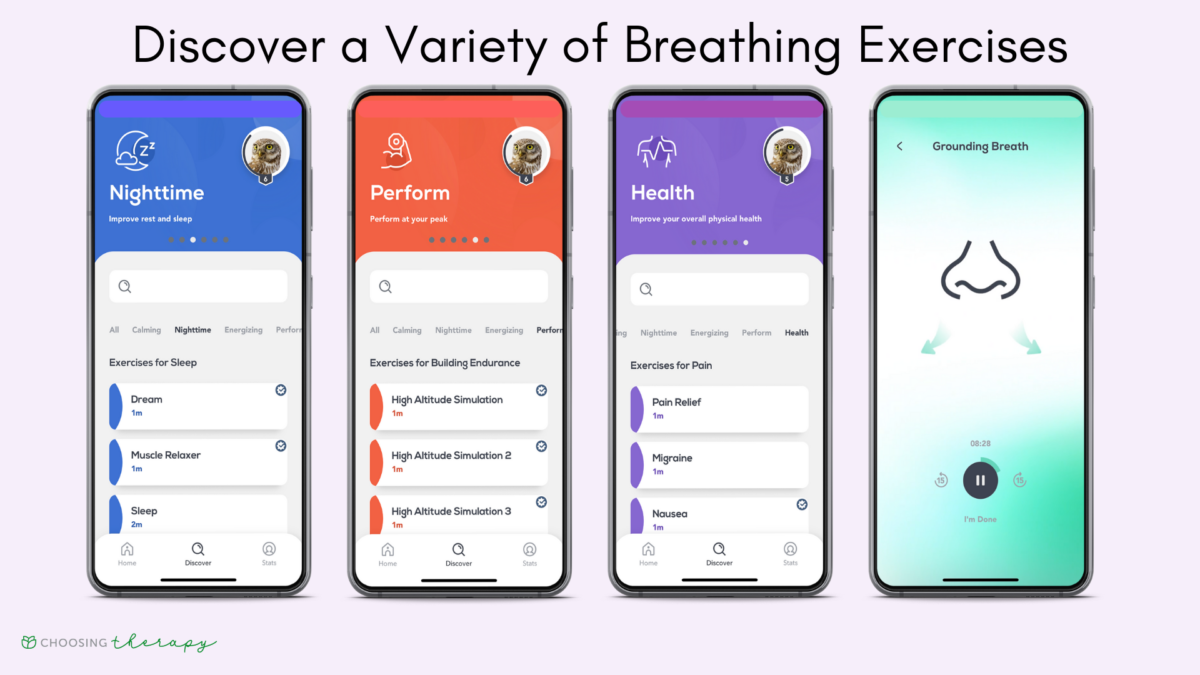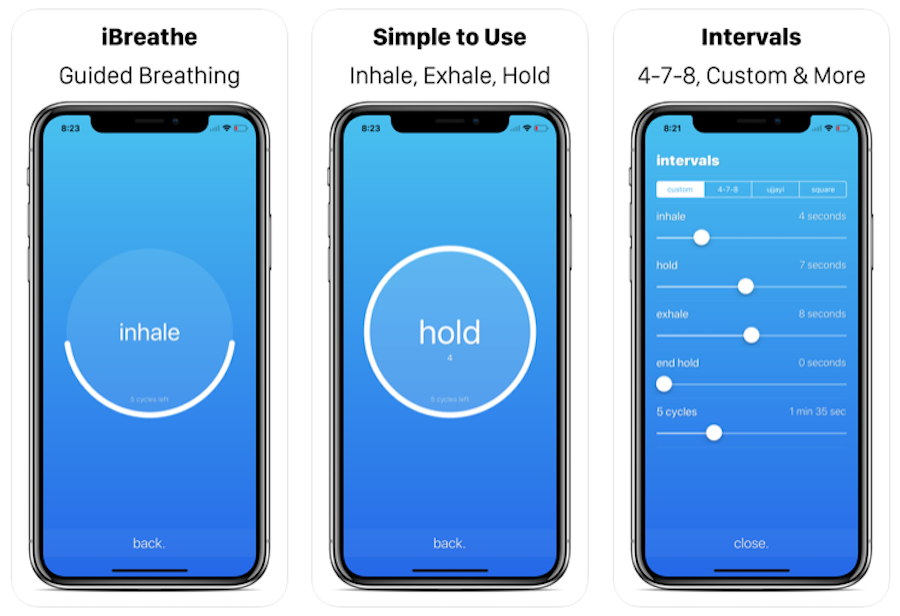Breathing exercises apps are gaining prominence, offering a myriad of benefits for physical and mental well-being. These apps guide users through structured breathing techniques, empowering them to improve their breathing patterns, reduce stress, and enhance their overall health.
From beginners to seasoned practitioners, breathing exercises apps cater to diverse needs. They employ various techniques, including diaphragmatic breathing, box breathing, and alternate nostril breathing, each with its unique advantages.
Benefits of Breathing Exercises Apps
Breathing exercises apps offer a myriad of physical and mental benefits, contributing to improved overall well-being and health. These apps guide users through various breathing techniques, enhancing breathing patterns and promoting relaxation.
Improved Breathing Patterns:Breathing exercises apps provide structured guidance on proper breathing techniques, such as diaphragmatic breathing and paced breathing. By practicing these techniques regularly, users can strengthen their respiratory muscles, improve lung capacity, and optimize oxygen intake.
Stress Reduction
Breathing exercises have a calming effect on the nervous system, reducing stress levels and promoting relaxation. When practiced regularly, these exercises activate the parasympathetic nervous system, which triggers a relaxation response in the body. This response slows heart rate, lowers blood pressure, and reduces muscle tension, leading to a sense of calm and tranquility.
Enhanced Sleep Quality
Breathing exercises can improve sleep quality by promoting relaxation and reducing stress levels. By practicing these exercises before bedtime, users can calm their minds, reduce racing thoughts, and prepare their bodies for restful sleep. Improved sleep quality has numerous benefits, including increased energy levels, improved cognitive function, and better overall health.
Increased Mindfulness
Breathing exercises apps often incorporate mindfulness techniques, such as body scans and meditation. By focusing on their breath, users can cultivate present-moment awareness and reduce distractions. Regular practice of these exercises can lead to increased mindfulness in daily life, reducing stress, improving focus, and enhancing overall well-being.
Types of Breathing Exercises Apps
Breathing exercises apps can be categorized into several types based on their features, target audience, and the specific techniques they employ.
Categories of Breathing Exercises Apps
| App Name | Target Audience | Specific Techniques | Key Benefits |
|---|---|---|---|
| Headspace | General audience | Mindfulness-based breathing, guided meditations | Stress reduction, improved focus, better sleep |
| Calm | General audience | Guided breathing exercises, nature sounds, sleep stories | Stress relief, relaxation, improved sleep quality |
| Pranayama | Yoga practitioners | Traditional pranayama techniques, personalized programs | Increased lung capacity, improved respiratory health, stress management |
| Buteyko Breathing Method | People with respiratory issues | Controlled breathing exercises, nasal breathing techniques | Reduced inflammation, improved asthma symptoms, better sleep |
| Wim Hof Method | Extreme sports enthusiasts, cold therapy practitioners | Controlled breathing, cold exposure, visualization | Increased tolerance to cold, improved immune function, stress reduction |
Each type of app has its own strengths and limitations. General audience apps like Headspace and Calm are accessible and easy to use, but they may not offer the same level of customization as apps designed for specific purposes like Pranayama or Buteyko Breathing Method.
App Design and Functionality
The design and functionality of breathing exercises apps play a crucial role in their effectiveness. User-friendly interfaces, clear instructions, and customizable settings enhance the user experience and promote regular practice.
Intuitive user interfaces guide users through the exercises with ease. Clear and concise instructions provide a step-by-step guide to each technique, while customizable settings allow users to tailor the exercises to their individual needs and preferences.
Tracking Progress and Feedback
Tracking progress and providing feedback to users are essential for motivation and adherence. Apps that track the duration and frequency of practice, as well as the user’s progress over time, help users stay motivated and see the benefits of their efforts.
Feedback mechanisms, such as visual cues or audio prompts, provide real-time guidance and encouragement during exercises. This feedback helps users maintain proper form and technique, ensuring they are getting the most out of their practice.
Integration with Other Health and Wellness Apps: Breathing Exercises Apps

Integrating breathing exercises apps with other health and wellness apps can significantly enhance overall health management and provide a more comprehensive approach to well-being. This integration allows users to track their progress, receive personalized recommendations, and connect with healthcare professionals, all within a single platform.
By integrating with fitness apps, users can track their breathing exercises alongside their physical activity data, gaining insights into how breathing techniques impact their overall fitness levels. Integration with meditation and mindfulness apps can enhance the relaxation and stress-reducing benefits of breathing exercises, providing a holistic approach to mental well-being.
Examples of Successful Integrations
- The Calm app, a popular meditation and mindfulness app, has integrated breathing exercises into its platform, allowing users to seamlessly incorporate breathing techniques into their daily meditation practice.
- The Fitbit app, a leading fitness tracker, has partnered with the Breathe app to provide users with guided breathing exercises tailored to their fitness goals and activity levels.
- The Oura ring, a sleep tracking device, has integrated with the Breathwrk app to monitor users’ breathing patterns during sleep, providing insights into sleep quality and the impact of breathing exercises on sleep.
Future Trends and Innovations

Breathing exercises apps are rapidly evolving, and several emerging trends are shaping their future. One significant trend is the integration of artificial intelligence (AI) into these apps. AI can provide personalized recommendations, track progress, and offer feedback, enhancing the user experience and effectiveness of breathing exercises.
Integration with Wearable Devices
The integration of breathing exercises apps with wearable devices, such as smartwatches and fitness trackers, is another growing trend. These devices can monitor physiological data, such as heart rate and breathing patterns, and provide real-time feedback to users. This integration enables more personalized and tailored breathing exercises, based on the user’s individual needs and progress.
Gamification and Social Features, Breathing exercises apps
Gamification and social features are becoming increasingly common in breathing exercises apps. Gamification elements, such as challenges, rewards, and leaderboards, can make breathing exercises more engaging and motivating. Social features, such as community forums and support groups, allow users to connect with others and share their experiences, fostering a sense of community and support.
Evidence-Based Approaches
The future of breathing exercises apps lies in the adoption of evidence-based approaches. This involves incorporating scientific research and clinical trials into the design and development of these apps, ensuring their effectiveness and credibility. Additionally, collaboration between healthcare professionals and app developers will be crucial in ensuring the accuracy and reliability of breathing exercises offered through these apps.
Conclusion

As technology advances, breathing exercises apps are poised to become even more sophisticated and accessible. The integration with other health and wellness apps, coupled with the potential of artificial intelligence and wearable devices, promises to revolutionize the way we manage our well-being through conscious breathing.
Frequently Asked Questions
How do breathing exercises apps work?
These apps provide guided instructions for specific breathing techniques, helping users regulate their breath and improve their breathing patterns.
Are breathing exercises apps effective?
Yes, studies have shown that regular use of breathing exercises apps can lead to significant improvements in breathing patterns, stress reduction, and overall well-being.
Are breathing exercises apps safe?
Generally, yes. However, it’s always advisable to consult with a healthcare professional before using any new breathing technique, especially if you have any underlying health conditions.
